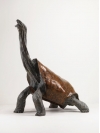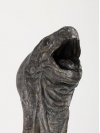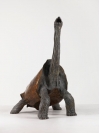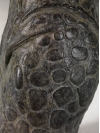
Rodrigues Giant Tortoise
By Nick Bibby- Size:
- 81 × 122 × 94cm
- Medium:
- Bronze
- Edition size:
- 10
Cylindraspis vosmaeri
The project to reconstruct the tortoise started deep in a cave on Rodrigues in December 1997. An expedition for the Natural History Museum, London and the Mauritian Wildlife Foundation was digging for bones of the extinct wildlife. The caves are in a calcarenite limestone area that is honeycombed with fissures and potholes. Some of the potholes drop vertically into caverns and it was there that tortoise remain were found. The creatures had fallen into the caverns, had died and lay undisturbed for centuries.
The remains were in good condition; the shells were virtually intact and looked as though they were only a few years old.
"As we held these bones and tortoise carapaces we felt we were reaching into the past, it was a very powerful experience. The connection was so strong it was as if we were going to uncover a living creature. I was so moved that I wanted to rebuild a tortoise to see what it would have looked like."
Dr Carl Jones
Using shells, bones and other museum material, backed up by early descriptions and accounts, Carl Jones, Pangolin Editions and the sculptor Nick Bibby have created a reconstruction which is as close to the living animal as is possible. The head was built upon a copy of a real skull, the body proportions were calculated from bones and the carapace is a remodelled copy of a specimen collected in the 18th Century.
As the tortoise model was being built, an animal began to emerge quite unlike the two-dimensional paintings and drawings of previous reconstructions. Having evolved in the absence of predators this tortoise had developed unique adaptations including a thin, light shell with unusually large apertures, giving greater mobility to the elongated legs and head. This species could browse leaves as high as four feet above the ground.
This giraffe-necked species of giant tortoise was found in enormous numbers on Rodrigues and is known to have been one of the species exported to Mauritius. The tortoises were harvested in large quantities to supply ships with fresh food and as living ballast. The ability of tortoises to survive for long periods without food and water made them popular prey and a welcome change from salted meats. Such was the pressure on the tortoise population that they are presumed to have been extinct that by 1802.




